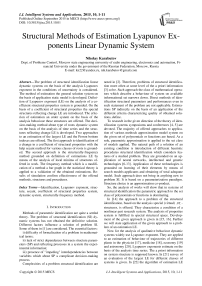Structural Methods of Estimation Lyapunov Ex-ponents Linear Dynamic System
Автор: Nikolay Karabutov
Журнал: International Journal of Intelligent Systems and Applications(IJISA) @ijisa
Статья в выпуске: 10 vol.7, 2015 года.
Бесплатный доступ
The problem of structural identification linear dynamic systems on the basis of the analysis Lyapunov exponent in the conditions of uncertainty is considered. The method of estimation the general solution system on the basis of application static model is developed. Defini-tion of Lyapunov exponent (LE) on the analysis of a coefficient structural properties system is grounded. On the basis of a coefficient of structural properties the special structures reflecting change LE are introduced. The criterion of estimation an order system on the basis of the analysis behaviour these structures are offered. The decision-making method about type of roots dynamic system on the basis of the analysis of time series and the structures reflecting change LE is developed. Two approaches to an estimation of the largest LE and the Perron bottom indexes are offered. The first approach to identification of a change in a coefficient of structural properties with the help secant method for various classes of roots is grounded. The second approach is the structurally-frequency method grounded on definition of estimations LE by means of the analysis of local minima of structures offered in work. The frequency method which is a modification of a method a bar graph in the statistical theory is applied to a validation of the obtained estimations. Results of simulation confirm effectiveness of the offered methods, structures and procedures.
Identification, Lyapunov exponent, struc-ture, secant, coefficient of structural properties system, dynamic system, structurally-frequency method
Короткий адрес: https://sciup.org/15010754
IDR: 15010754
Список литературы Structural Methods of Estimation Lyapunov Ex-ponents Linear Dynamic System
- N.N. Karabutov, “Structural identification of nonlinear static system on basis of analysis sector sets. International journal intelligent systems and applications,” 2013, vol.6, no. 1, pp. 1-10.
- I.V. Prangishvili, V.А. Lototsky, K.S. Ginsberg, and V.V. Smoljaninov, “Identification of systems and a control prob-lem: on a path to modern system technologies,” Control problems, 2004, no. 4, pp. 2-16.
- T. Bohlin, and S.F. Graebe, “Issues in nonlinear stochastic grey box identification,” International journal of adaptive control and signal processing, 1995, vol. 9, no. 6, pp. 461–464.
- Proceedings of the VIII International Conference “System Identification and Control Problems” SIC'PRO ‘08. Mos-cow, January 26-30, 2009. Moscow: V.A. Trapeznikov In-stitute of Control Sciences. Moscow: IPU RAN, 2009.
- Proceedings of the XI International Conference “System Identification and Control Problems” SIC'PRO ‘12. Mos-cow, January 26-February 02, 2012. Moscow: V.A. Trapeznikov Institute of Control Sciences, 2015. Moscow: IPU RAN, 2012.
- H. Adeli, and X. Jiang, “Dynamic Fuzzy Wavelet Neural Network Model for Structural System Identification,” Journal of structural engineering, 2006, vol. 132, no. 1, pp.102-111.
- R. Babu?ka, H. Verbruggen, “Neuro-fuzzy methods for nonlinear system identification,” Annual reviews in control, 2003, vol. 27, no. 1, pp. 73-85.
- J. Ghaboussi, Jr.J. Garrett Jr.J., and X. Wu, “Knowledge based modeling of material behavior with neural networks,” Journal of engineering mechanics,” 1991, vol. 117, no. 1, 132~153.
- F.A. Guerraa, and L. Coelho, “Multi-step ahead nonlinear identification of Lorenz’s chaotic system using radial basis neural network with learning by clustering and particle swarm optimization.” Chaos, Solitons and Fractals, 2008, vol. 35, no. 5, pp. 967-979.
- S. Srivastava, M. Singh, M. Hanmandlu, and A.N. Jha, “Modeling of non-linear systems by FWNNs and their in-telligent control,” International journal of adaptive control and signal processing, 2005, vol. 19, no. 7, pp. 505-530.
- N.V. George, and G. Panda, “Development of a novel ro-bust identification scheme for nonlinear dynamic systems,” International journal of adaptive control and signal pro-cessing, Article first published online: 16 MAR 2014.
- X. Xu, C. Wang, and F.L. Lewis, “Some recent advances in learning and adaptation for uncertain feedback control systems,” International journal of adaptive control and signal processing, 2014, vol. 28, no. 3-5, pp. 201-204.
- W. Yu, “Nonlinear system identification using discrete-time recurrent neural networks with stable learning algorithms,” Information Sciences, 2004, vol. 158, pp. 131–147.
- N.N. Karabutov, Structural Identification of Systems. The Analysis of Information Structures. Moscow: URSS/ Librokom, 2009.
- N.N. Karabutov, Structural identification of static objects: Fields, structures, methods. Moscow: Librokom, 2011.
- N.N. Karabutov, Methods of structural identification non-linear plants. Saarbrucken: Palmarium Academic Publishing, 2014.
- K. Thamilmaran, D.V. Senthilkumar, A. Venkatesan, and M. Lakshmanan, “Experimental realization of strange non-chaotic attractors in a quasiperiodically forced electronic circuit,” Physical Review E, 2006, vol. 74, no. 9, pp. 036205.
- R. Porcher, and G. Thomas, “Estimating Lyapunov expo-nents in biomedical time series,” Physical Review E, 2001, vol. 64, no. 1, pp. 010902(R).
- J.A. Ho?yst, and K. Urbanowicz, “Chaos control in eco-nomical model by time-delayed feedback method,” Physica A: Statistical Mechanics and its Applications, 2000, vol. 287, no. 3-4, pp. 587-598.
- W.M. Macek, and S. Redaelli, “Estimation of the entropy of the solar wind flow,” Physical Review E, 2000, vol. 62, no. 5, pp. 6496-6504.
- Ch. Skokos, “The Lyapunov characteristic exponents and their computation,” Lect. Notes Phys, 2010, vol. 790, pp. 63-135.
- R.Gencay, and W.D. Dechert, “An algorithm for the n Lya-punov exponents of an n-dimensional unknown dynamical system,” Physica D, 1992, vol. 59, pp. 142-157.
- N.N. Karabutov, “Deriving a dynamic system eigenvalue spectrum under conditions of uncertainty by processing measurements,” Measurement Techniques, 2009, vol. 52, no. 6, pp. 571-579.
- B.F. Bylov, R.E. Vinograd, D.M. Grobman, and V.V. Ne-mytsky, Theory of Lyapunov indexes and its application to stability problems. Moscow: Nauka, 1966.
- N.A. Izobov, Introduction in theory of Lyapunov indexes. Minsk: BGU, 2006.
- M.V. Fedorchuk, Ordinary differential equations. Moscow: Nauka, 1985.
- N.N. Karabutov N.N., V.М. Lokhin, S.V. Manko, and M.P. Romanov, “Structure identification of dynamic plants on the basis of the analysis of the Lyapunov characteristic in-dexes,” in Proceedings of the X International Conference “System Identification and Control Problems” SIC'PRO ‘15. Moscow, January 26-29, 2015. Moscow: V.A. Trapez-nikov Institute of Control Sciences, 2015. Moscow: IPU RAN, 2015, pp. 602-616.


